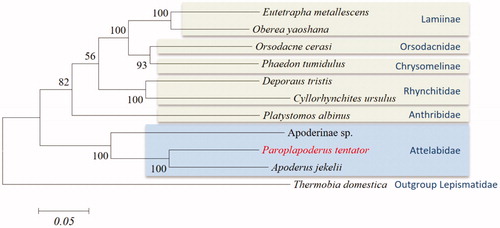Abstract
For the first time, we report the complete mitochondrial genome of Paroplapoderus tentator Faust, which is 163,47 bp in length. The total number of genes in the genome was 41, including 13 PCGs; 2 rRNA genes; 19 tRNA genes; and 7 replication initiation region OHs. The genome consisted of 39.32% A, 34.17% T, 9.75% C, and 16.76% G. Phylogenetic trees indicate that Paroplapoderus is closely related to Apoderus. This study provided additional information on molecular biology for the research of Attelabidae, laying the foundation for further research on their phylogenetics.
Paroplapoderus tentator (Coleoptera: Attleabidae) is an unidentified species distributed in Yunnan, China. The adults’ head, pronotum, and elytra are covered with black spots, and each elytron has two black spinous process arranged in front and back. All the species in Attleabidae, including the current P. tentator, would experience a special breeding period, in which the females cut, curl, and place their eggs in a leaf roll to provide food and shelter for her offspring (Kono Citation1930; Kobayashi and Kato Citation2004). The rolling behavior used to last for several hours, and there is only one egg laid by the female in a cradle in most case. But so far, minimal number of studies have been reported about these weevils with special behavior, especially in mitochondrial genome. In this study, we reported the complete mitochondrial genome information of P. tentator for the first time, which would contribute to the further studies on this taxon.
The samples used in this study were collected by Jingying Du et al. in Pingbian county, Yunnan, China (22°54′51.42″N, 103°48′57.09″E) in April 2019. Samples were stored in –80° C at the Zoological Museum of Sichuan Agricultural University (No. 986-11) in Ya‘an, Sichuan, China. Fifteen samples were sent to Shanghai Personal Biotechnology, where a complete mitochondrial genome was obtained by next-generation sequencing.
Complete mitochondrial genome of P. tentator was 16,347 bp, consisting of 39.32% A, 34.17% T, 9.75% G, and 16.76% C. Complete mitochondrial genome sequences assembled by the company were uploaded to the MITOS web server (http://mitos.bioinf.uni-leipzig.de/) for functional annotation (Bernt et al. Citation2013). Among them, Genetic Code was selected to set to 05-inverterbrate, while the rest were set to the default parameters set by MITOS. The total number of genes in the genome was 41, including 13 protein-coding genes, 2 ribosomal RNA genes, 19 transporter RNA genes, and 7 Replication initiation region OHs. Of the 13 protein-coding genes, 9 were in the justice chain and 4 were in the negative-sense chain. The length of tRNAs ranged from 63 bp to 72 bp, while the length of small subunit rRNA was 745 bp, and the length of large subunit rRNA was 1237 bp. Six replication initiation region OHs were distributed after tRNA-gat gene and small subunit rRNA, respectively, with a total of 491 bp. The last replication initiation region OH was located between tRNA-tga2 and nad1 genes, with a size of 74 bp. We have deposited the P. tentator sequence in GenBank. The accession number is MT113120.
Ten mitochondrial genomes (including the one obtained in this study) of species in Coleoptera were used for phylogenetic analysis, and Thermobia domestica (Lepismatidae: Thermobia) was selected as the outgroup. Trees were visualized with MEGA6.0, choose ‘Kimura 2-parameter’ model, The UPGMA tree was obtained by repeating bootstrap 1000 times. The results show that P. tentator is closely related to Apoderus jekelii (). Three species in Attelabidae form a monophyletic group, while Rhynchitidae, which was considered as subfamily of Attelabidae sometimes (Lv et al. Citation2016), forms another single group based on the present study.
Figure 1. GenBank accession numbers are as follows: Eutetrapha metallescens (Lamiinae), KY796053 (Wang et al. Citation2019); Oberea yaoshana (Lamiinae), MK863509 (Wang et al. Citation2019); Orsodacne cerasi (Orsodacnidae), KX087325; Phaedon tumidulus (Chrysomelidae), KX943499; Deporaus tristis (Rhynchitidae), KX087280 (Linard et al. Citation2018); Cyllorhynchites ursulus (Rhynchitidae), MH156809 (Lee et al. Citation2019); Platystomos albinus (Anthribidae), KX087337 (Linard et al. Citation2018); Apoderinae sp. (Attleabidae), MH473531 (Gillett et al. Citation2014); Apoderus jekelii (Attelabidae), MK292540 (Park et al. Citation2019); and the outgroup species Thermobia domestica (Lepismatidae), NC006080 (Hua et al. Citation2009).

Disclosure statement
No potential conflict of interest was reported by the author(s).
Additional information
Funding
References
- Bernt M, Donath A, Juhling F, Externbrink F, Florentz C, Fritzsch G, Putz J, Middendorf M, Stadler PF. 2013. MITOS: improved de novo metazoan mitochondrial genome annotation. Mol Phylogenet Evol. 69(2):313–319.
- Gillett CP, Crampton-Platt A, Timmermans MJ, Jordal BH, Emerson BC, Vogler AP. 2014. Bulk de novo mitogenome assembly from pooled total DNA elucidates the phylogeny of weevils (Coleoptera: Curculionoidea). Mol Biol Evol. 31(8):2223–2237.
- Hua J, Li M, Dong P, Xie Q, Bu W. 2009. The mitochondrial genome of Protohermes concolorus yang et yang 1988 (Insecta: Megaloptera: Corydalidae). Mol Biol Rep. 36(7):1757–1765.
- Kobayashi C, Kato M. 2004. To be suspended or to be cut off? Differences in the performance of two types of leaf-rolls constructed by the Attelabid beetle Cycnotrachelus roelofsi. Popul Ecol. 46(2):193–202.
- Kono H. 1930. Die biologischen gruppen der Rhynchitinen, Attelabinen und Apoderinen. J Fac Agric Hokkaido Univ. 29:1–36.
- Lee H, Park J, Lee J, Hong K-J, Park J, Lee W. 2019. The complete mitochondrial genome of Ceutorhynchus obstrictus (marsham, 1802) (Coleoptera: Curculionidae). Mitochondrial DNA Part B. 4(2):3096–3098.
- Linard B, Crampton-Platt A, Moriniere J, Timmermans MJTN, Andújar C, Arribas P, Miller KE, Lipecki J, Favreau E, Hunter A, et al. 2018. The contribution of mitochondrial metagenomics to large-scale data mining and phylogenetic analysis of Coleoptera. Mol Phylogenet Evol. 128:1–11.
- Lv X, Alonsozarazaga MA, Xiao Z, Wang Z, Zhang R. 2016. Evemphyron sinense, a new genus and species infesting legume seedpods in china (Coleoptera, Attelabidae, Rhynchitinae). Zookeys. 600(600):89–101.
- Park J, Kim MJ, Kim I. 2019. Complete mitochondrial genome of the leaf-rolling-weevil, Apoderus jekelii roelofs, 1874 (Coleoptera: Attelabidae). Mitochondrial DNA Part B. 4(1):995–997.
- Wang J, Dai XY, Xu XD, Zhang ZY, Yu DN, Kenneth B, Zhang JY. 2019. The complete mitochondrial genomes of five longicorn beetles (Coleoptera: Cerambycidae) and phylogenetic relationships within Cerambycidae. PeerJ. 7:e7633.
